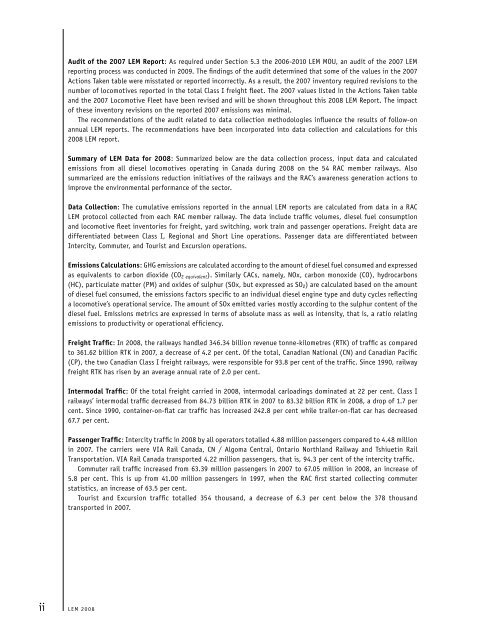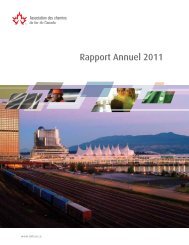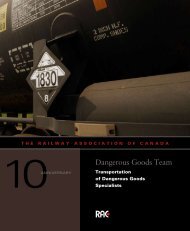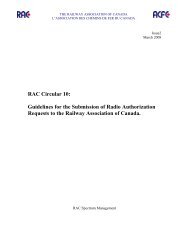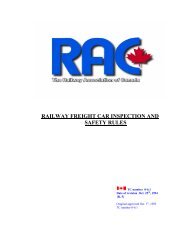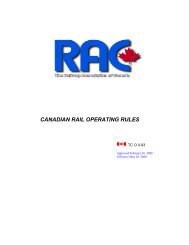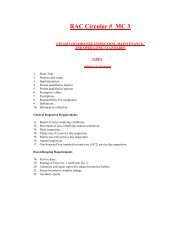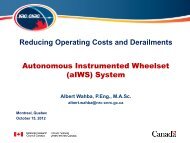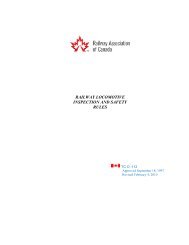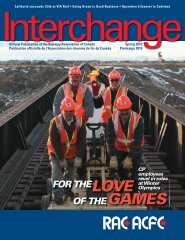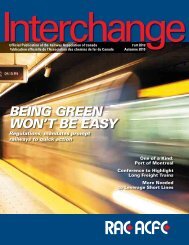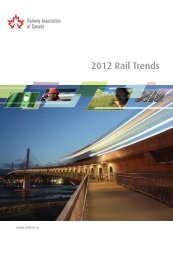Locomotive Emissions Monitoring Program - Railway Association of ...
Locomotive Emissions Monitoring Program - Railway Association of ...
Locomotive Emissions Monitoring Program - Railway Association of ...
You also want an ePaper? Increase the reach of your titles
YUMPU automatically turns print PDFs into web optimized ePapers that Google loves.
Audit <strong>of</strong> the 2007 LEM Report: As required under Section 5.3 the 2006-2010 LEM MOU, an audit <strong>of</strong> the 2007 LEM<br />
reporting process was conducted in 2009. The findings <strong>of</strong> the audit determined that some <strong>of</strong> the values in the 2007<br />
Actions Taken table were misstated or reported incorrectly. As a result, the 2007 inventory required revisions to the<br />
number <strong>of</strong> locomotives reported in the total Class I freight fleet. The 2007 values listed in the Actions Taken table<br />
and the 2007 <strong>Locomotive</strong> Fleet have been revised and will be shown throughout this 2008 LEM Report. The impact<br />
<strong>of</strong> these inventory revisions on the reported 2007 emissions was minimal.<br />
The recommendations <strong>of</strong> the audit related to data collection methodologies influence the results <strong>of</strong> follow-on<br />
annual LEM reports. The recommendations have been incorporated into data collection and calculations for this<br />
2008 LEM report.<br />
Summary <strong>of</strong> LEM Data for 2008: Summarized below are the data collection process, input data and calculated<br />
emissions from all diesel locomotives operating in Canada during 2008 on the 54 RAC member railways. Also<br />
summarized are the emissions reduction initiatives <strong>of</strong> the railways and the RAC’s awareness generation actions to<br />
improve the environmental performance <strong>of</strong> the sector.<br />
Data Collection: The cumulative emissions reported in the annual LEM reports are calculated from data in a RAC<br />
LEM protocol collected from each RAC member railway. The data include traffic volumes, diesel fuel consumption<br />
and locomotive fleet inventories for freight, yard switching, work train and passenger operations. Freight data are<br />
differentiated between Class I, Regional and Short Line operations. Passenger data are differentiated between<br />
Intercity, Commuter, and Tourist and Excursion operations.<br />
<strong>Emissions</strong> Calculations: GHG emissions are calculated according to the amount <strong>of</strong> diesel fuel consumed and expressed<br />
as equivalents to carbon dioxide (CO 2 equivalent ). Similarly CACs, namely, NOx, carbon monoxide (CO), hydrocarbons<br />
(HC), particulate matter (PM) and oxides <strong>of</strong> sulphur (SOx, but expressed as SO 2 ) are calculated based on the amount<br />
<strong>of</strong> diesel fuel consumed, the emissions factors specific to an individual diesel engine type and duty cycles reflecting<br />
a locomotive’s operational service. The amount <strong>of</strong> SOx emitted varies mostly according to the sulphur content <strong>of</strong> the<br />
diesel fuel. <strong>Emissions</strong> metrics are expressed in terms <strong>of</strong> absolute mass as well as intensity, that is, a ratio relating<br />
emissions to productivity or operational efficiency.<br />
Freight Traffic: In 2008, the railways handled 346.34 billion revenue tonne-kilometres (RTK) <strong>of</strong> traffic as compared<br />
to 361.62 billion RTK in 2007, a decrease <strong>of</strong> 4.2 per cent. Of the total, Canadian National (CN) and Canadian Pacific<br />
(CP), the two Canadian Class I freight railways, were responsible for 93.8 per cent <strong>of</strong> the traffic. Since 1990, railway<br />
freight RTK has risen by an average annual rate <strong>of</strong> 2.0 per cent.<br />
Intermodal Traffic: Of the total freight carried in 2008, intermodal carloadings dominated at 22 per cent. Class I<br />
railways’ intermodal traffic decreased from 84.73 billion RTK in 2007 to 83.32 billion RTK in 2008, a drop <strong>of</strong> 1.7 per<br />
cent. Since 1990, container-on-flat car traffic has increased 242.8 per cent while trailer-on-flat car has decreased<br />
67.7 per cent.<br />
Passenger Traffic: Intercity traffic in 2008 by all operators totalled 4.88 million passengers compared to 4.48 million<br />
in 2007. The carriers were VIA Rail Canada, CN / Algoma Central, Ontario Northland <strong>Railway</strong> and Tshiuetin Rail<br />
Transportation. VIA Rail Canada transported 4.22 million passengers, that is, 94.3 per cent <strong>of</strong> the intercity traffic.<br />
Commuter rail traffic increased from 63.39 million passengers in 2007 to 67.05 million in 2008, an increase <strong>of</strong><br />
5.8 per cent. This is up from 41.00 million passengers in 1997, when the RAC first started collecting commuter<br />
statistics, an increase <strong>of</strong> 63.5 per cent.<br />
Tourist and Excursion traffic totalled 354 thousand, a decrease <strong>of</strong> 6.3 per cent below the 378 thousand<br />
transported in 2007.<br />
ii LEM 2008


